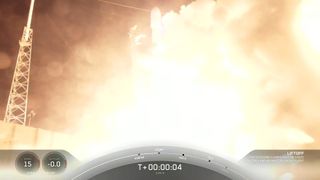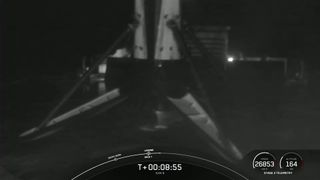SpaceX rocket launches Sirius XM digital radio satellite, nails nighttime landing at sea
The SXM-8 satellite lifted off in a dazzling nighttime launch.
CAPE CANAVERAL, Fla. — SpaceX launched a veteran Falcon 9 rocket on its third trip to space Sunday (June 6) to carry a massive radio satellite into orbit for Sirius XM before returning to Earth.
The two-stage Falcon 9 rocket blasted off at 12:26 a.m. EDT (0426 GMT) from Space Launch Complex 40 here at Cape Canaveral Space Force Station, marking the company's 18th launch of the year. It carried the SXM-8 digital radio satellite into orbit for customer Sirius XM.
Approximately 9 minutes later, the booster's first stage returned to Earth, landing on one of SpaceX's two drone ships, called "Just Read The Instructions" stationed out in the Atlantic Ocean. The launch occurred at the start of a nearly 2-hour window.
"We have touchdown of Falcon 9," said SpaceX’s Jessie Anderson during the launch webcast. "Today marks the 87th overall successful recovery of an orbital class rocket."
Related: See the evolution of SpaceX's rockets in pictures

The mission marked the second SpaceX launch in just three days from Florida's space coast, as a different Falcon 9 blasted off from Pad 39A at the nearby Kennedy Space Center on Thursday afternoon (June 3). Its payload: a gumdrop-shaped cargo capsule bound for the International Space Station that arrived at the orbiting laboratory on Saturday morning to deliver 7,300-lbs. (3,311 kilograms) of science gear and supplies.
Forecasters at the 45th Space Delta's weather squadron predicted only a 60% chance of favorable launch conditions due residual clouds left over from some late night storms on Saturday. Despite the iffy outlook, SpaceX was able to launch right on time.
Get the Space.com Newsletter
Breaking space news, the latest updates on rocket launches, skywatching events and more!
The cloud layer provided some cool visuals as the sky glowed orange as the rocket climbed through the cloud layers on its way to orbit.
A triple spaceflier

For this mission, the 230-foot-tall (70 m) Falcon 9 successfully delivered the high-powered radio broadcasting satellite Sirius XM-8 (SXM-8) into orbit. Built by Maxar Technologies for Sirius XM, it's one of two satellites to be launched by SpaceX to replace outdated ones currently on orbit.
The rocket’s first stage booster, now with three successful launches and landings under its belt, touched down on SpaceX's "Just Read the Instructions" drone ship, which was waiting in the Atlantic. It marks the 87th recovery of a first stage booster for the California-based rocket manufacturer.
The rocket featured in Sunday's predawn launch is another historic booster. Known as B1061, this flight-proven booster has carried two different astronaut crews to the space station, marking the first time humans flew on a reused booster. That historic mission blasted off from Kennedy Space Center on April 23. The rocket's first flight, dubbed Crew-1, launched in November 2020.

For this third flight, it switched up its cargo, carrying a 15,432-lb. (7,000-kg) satellite into orbit for Sirius XM. The satellite will beam down more than 8,000 watts of content to Sirius subscribers across the U.S., Canada and the Caribbean. This is the second such satellite SpaceX has launched on behalf of Sirius, with the first (SXM-7) launching in December 2020.
That satellite was declared lost after it experienced a payload failure earlier this year, during an orbit-raising maneuver. Sirius confirmed the failure in January, and in a recent earnings report in April said it had $225 million in insurance coverage for the satellite which covered launch and the first year's operations. Sirius does expect to file a claim for its lost satellite and is looking to build another satellite to replace SXM-7.
The company says that the loss will not affect its satellite radio service, and that SXM-7 was expected to replace the XM-3 satellite that launched in 2005. Sirius intended for SXM-7 and SXM-8 to replace satellites XM-3 and XM-4, but those satellites remain operational and have several years life expectancy left. (There is also an in-orbit spare, XM-5, which can fill in if necessary.)
Officials have not disclosed if any modifications were made to SXM-8 after the loss of the other satellite.

Both were based on Maxar Technologies' SSL-1300 satellite bus and were designed to operate in the S-band spectrum. It's outfitted with two large solar arrays as well as batteries for on-orbit storage. Large deployable S-band antennas, built by L3, broadcast the signal down to Sirius customers.
The launch of SiriusXM’s SXM-8 satellite continues a busy run of launches for SpaceX.
In May, the company launched four different Starlink missions, bringing the total number of its own broadband satellites launched up to 1,737.
Sunday’s flight marks the second so far in June, with two more on the schedule later this month. One of those missions will launch an upgraded GPS III satellite for the U.S. Space Force. And it will be the first military payload to fly on a reused rocket.
To prepare for this flight, SpaceX test-fired the veteran booster early Thursday morning (June 3), before the launch of a Dragon cargo mission at a neighboring launch pad. Following the test, the rocket was transported back into the hangar to be mated with its payload.
SoaceX will attempt to recover the rocket’s payload fairings after they jettison during flight. The clamshell-like hardware is designed to protect the payload as the rocket flies through the atmosphere.
To facilitate this type of reuse, SpaceX has deployed two boats that typically transport Dragon capsules. GO Searcher and GO Navigator are in the designated recovery zone, waiting to retrieve the falling fairings.
The company used to rely on a pair of net-equipped boats to recover the fairings, either catching them in mid-air or scooping them out of the water. However, SpaceX has since refined its recovery techniques and upgraded the payloads fairings to better withstand a dip in the ocean.
As a result the company ditched its mid-air strategy and instead opted to fetch the fairings from the water after each flight.
Up next for SpaceX is the launch of an upgraded GPS satellite for the U.S. military. That mission is scheduled to lift off from Space Launch Complex 40 here at Cape Canaveral Space Force Station on June 17.
Follow Amy Thompson on Twitter @astrogingersnap. Follow us on Twitter @Spacedotcom or Facebook.
Join our Space Forums to keep talking space on the latest missions, night sky and more! And if you have a news tip, correction or comment, let us know at: community@space.com.

Amy Thompson is a Florida-based space and science journalist, who joined Space.com as a contributing writer in 2015. She's passionate about all things space and is a huge science and science-fiction geek. Star Wars is her favorite fandom, with that sassy little droid, R2D2 being her favorite. She studied science at the University of Florida, earning a degree in microbiology. Her work has also been published in Newsweek, VICE, Smithsonian, and many more. Now she chases rockets, writing about launches, commercial space, space station science, and everything in between.
